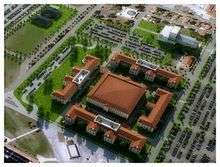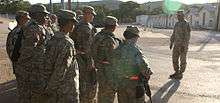United States Army Installation Management Command
| United States Army Installation Management Command | |
|---|---|
 IMCOM Unit Crest | |
| Active | October 2006 – Present |
| Country |
|
| Branch | United States Army |
| Type | Direct Reporting Unit |
| Size | Approx. 50,000 |
| Part of | Department of the Army |
| Nickname(s) | IMCOM |
| Motto(s) | We are The Army's Home, Serving the Rugged Professional |
| Colors |
Red, green, black & gold |
| Anniversaries | Oct. 24 |
| Website | https://imcom.army.mil/ |
| Commanders | |
| Commanding General | LTG Kenneth R. Dahl |
| Deputy Commanding General | MG Warren E. Phipps, Jr. |
| Chief of Staff | Mr. Joseph C. Capps |
| Command Sergeant Major | CSM Jeffrey S. Hartless |
Mission
The United States Army Installation Management Command supports the United States Army's warfighting mission by handling the day-to-day operations of U.S. Army installations around the globe. Army garrisons are communities that provide many of the same types of services expected from any small city. Fire, police, housing, and child-care are just some of the things IMCOM does in Army communities every day.[1] IMCOM's vision statement is: Committed to Service — Enhancing Readiness — Sustaining the Army Culture.
IMCOM is headquartered in San Antonio, TX on Fort Sam Houston. IMCOM's headquarters relocated in October, 2010[2] from Arlington, Virginia as part of the Base Realignment and Closure Act of 2005.[3]
History

The United States Army Installation Management Command (IMCOM),[4] was activated on 24 Oct. 2006,[5] to reduce bureaucracy, apply a uniform business structure to manage U.S. Army installations, sustain the environment[6] and enhance the well-being of the military community.[7] It consolidated three organizations under a single command as a direct reporting unit:[8]
- The former Installation Management Agency (IMA)[9]
- The former Community and Family Support Center,[10] now called G9 Family and MWR Programs,[11] which was formerly a subordinate command of IMCOM.
- The former Army Environmental Center,[12] now called the Army Environmental Command (AEC), which is a subordinate command of IMCOM.[13]
Prior to the Installation Management Command, the Army's 184 installations[14] were managed by one of 15 Major Commands. Support services varied – some provided better services, some provided worse. In September 2001, Army Secretary Thomas E. White introduced the Transformation of Installation Management (TIM),[15] formerly known as Centralized Installation Management (CIM), pledging the Army would implement better business practices and realign installation management to create a more efficient and effective corporate management structure for Army installations worldwide. On 1 Oct. 2002, the Army formed IMA as a field operating agency of the Assistant Chief of Staff for Installation Management (ACSIM) as part of an ongoing effort to realign installations.[16]
Many of the issues with the 15 major commands (List of Major Commands of the United States Army) holding responsibility for base support was that the structure created many inequities throughout the Army. There were no common standards, consistent services or an acutely managed infrastructure. This created an environment where funding was often diverted from installation support to operations. Additionally, there were too many military personnel conducting garrison support operations rather than mission duties. The creation of IMCOM was a commitment to eliminate these inequities, focus on installation management and enhance the well-being of Soldiers, Families and Civilians.
Centralizing installation management was a culture change in the Army; working through the transfers of personnel and funding issues was difficult. In a large organizational change, IMCOM became the Army’s single agency responsible for worldwide installation management, managing 184 Army installations globally with a staff of 120,000 military, civilian and contract members across seven regions on four continents.[17]
Total Army Strong[18]
Originally named "The Army Family Covenant" in 2007, Army leaders undertook a long-term commitment to resource and standardize critical support programs for Soldiers, their families and civilians. The covenant was focused on specific programs which commanders couldn't change. The focus was:
- Standardizing and funding existing family programs and services
- Increasing accessibility and quality of healthcare
- Improving Soldier and family housing
- Ensuring excellence in schools, youth services, and child care
- Expanding education and employment opportunities for family members"[19]
In 2014, the program was renamed "Total Army Strong" and commanders were given the flexibility of tailoring local programs best suit their communities.
The Army Family Covenant is the Army’s statement of commitment to provide high quality services to Soldiers – Active component or Reserve components, single or married, regardless of where they serve – and their Families.
The Installation Management Command supports the Total Army Strong[20] and provides a set of tools Soldiers and Army Families can use to locate and access the facilities and services they need.[21]
IMCOM today


IMCOM currently manages:
- Workforce of 54,000
- 28 airfields
- 2,643 miles (4,253 km) of railroad
- 59,007 miles (94,963 km) of roads
- 47,803 miles (76,931 km) of utilities
- 92,000 trainee barracks spaces
- 583,000 Family and single housing units
- 973,000,000 sq ft (90,400,000 m2) of building space
- 9 Community Based Health Care Organizations
- 39 Soldier and Family Assistance Centers
- 35 Warrior Transition Units
- 53 educational centers
- 53 golf courses
- 89 bowling centers
- 93 libraries
- 167 child developmental centers
- 302 chapels
- 714 fitness, aquatic, athletic and recreational facilities
- 16 individual chemical equipment
- Management program storage sites
- 28 training support centers
- 60 record holding areas
- 63 central issue facilities
- 88 official mail and distribution centers
- 286 garrison dining facilities[22]
IMCOM Directorates
The regions administered by the United States Army Installation Management Command are:[23]
- Installation Management Command Central Region[24]
- Installation Management Command Atlantic Region[25]
- Installation Management Command Pacific Region[26]
- Installation Management Command Europe Region[27]

Installations by IMCOM Directorate
- Note: 'USAG' denotes a United States Army Garrison
See also
- Department of Defense Education Activity for example, DoD-funded high schools
- List of United States Army installations
References
- ↑ The IMCOM Mission
- ↑ "New Installation Management Command opens – Army News , News from Afghanistan & Iraq". Army Times. 5 October 2010. Retrieved 21 May 2011.
- ↑ "Environmental command stakes its claim at Fort Sam Houston". Army.mil. 28 May 2010. Retrieved 21 May 2011.
- ↑ "IMCOM Official Web Site". Imcom.army.mil. Retrieved 21 May 2011.
- ↑ John Pike (4 August 2006). "U.S. Army Announces Installation Management Command Activation". Globalsecurity.org. Retrieved 21 May 2011.
- ↑ "US Army Environmental Command". Aec.army.mil. Retrieved 21 May 2011.
- ↑ "Army Family and Morale, Welfare and Recreation". Armymwr.biz. Retrieved 21 May 2011.
- ↑ "Installation management command activated , Army Logistician , Find Articles at BNET". Findarticles.com. Retrieved 21 May 2011.
- ↑ "US News & World Report Article". Usnews.com. Retrieved 21 May 2011.
- ↑ "Fact Sheet" (PDF). Retrieved 21 May 2011.
- ↑ "FMWR at". Army.mil. Retrieved 21 May 2011.
- ↑ "Borland Case Study" (PDF). Retrieved 21 May 2011.
- ↑ "Army Environmental Command Organizational Structure". Aec.army.mil. Retrieved 21 May 2011.
- ↑ "Army Organization". Army.mil. Retrieved 21 May 2011.
- ↑ Army begins installation transformation
- ↑ "Transformation of Installation Management" (PDF). Retrieved 21 May 2011.
- ↑ http://www.imcom.army.mil/hq/kd/cache/files/69B948B6-423D-452D-4636808C49A57094.pdf
- ↑ "STAND-TO!". STAND-TO!. Retrieved 2016-10-24.
- ↑ "Army Family Covenant – IMCOM HQ". Imcom.army.mil. Retrieved 21 May 2011.
- ↑ "The Army News Service". army.mil. Retrieved October 15, 2014.
- ↑ "Army Family Toolbox – IMCOM HQ". Imcom.army.mil. Retrieved 21 May 2011.
- ↑ "IMCOM Fact Sheet – IMCOM HQ". Imcom.army.mil. 26 October 2006. Retrieved 21 May 2011.
- ↑ "Garrisons By Region – IMCOM HQ". Imcom.army.mil. Retrieved 21 May 2011.
- ↑ http://www.imcom.army.mil/regions/central/
- ↑ http://www.imcom.army.mil/regions/atlantic/
- ↑ "IMCOM-Pacific". Imcom.pac.army.mil. Retrieved 21 May 2011.
- ↑ "IMCOM-Europe". imcom-europe.army.mil. Retrieved 4 April 2012.